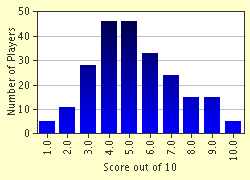Quiz Answer Key and Fun Facts
1. It's launch day, and Rocky is sitting on Pad 39B at Cape Canaveral, FL. The latitude and longitude of the launch pad is 28.5°N, 80.5°W. Which of the following is true?
2. While in Low Earth Orbit, Rocky is experiencing zero gravity.
3. Rocky is now orbiting around the Earth. According to Kepler's First Law of Planetary Motion, the orbital path best resembles this shape.
4. Kepler's Second Law of Planetary Motion states "A line joining a planet and its star sweeps out equal areas during equal intervals of time." Using this information, if Rocky's orbit is not circular, which of the following is true?
5. Rocky wants to go to a higher orbit. He performs a burn in his direction of motion increasing his apogee, then while at the orbital apogee, performs another burn to circularize his new orbit. What did Rocky just perform?
6. Rocky performed an orbital adjustment burn. The inclination of his new orbit is now 0°. It doesn't seem like he's moving around the Earth at all; when he looks down he just sees the same spot all the time. Which of the following is true?
7. Rocky has a mass of 10,000 kg. He is in the same orbit as a small piece of orbital debris, with a mass of 1g, and a 10kg asteroid. Which one takes longer to orbit the Earth?
8. In order to escape Earth's gravity, Rocky must launch with a velocity, or delta V, of 11.3 km/s. On his first launch, he launched into orbit with a delta V of 9 km/s, and the second time with a delta V of 10 km/s. After reaching orbit, which launch allowed Rocky to orbit the Earth in less time, or had a smaller period?
9. Rocky is travelling around the Moon and back to Earth using a gravitational slingshot. His trajectory is much like that of Apollo 13. Which can best describe a gravitational slingshot?
10. Rocky decides to venture out into space even further. He is now in a heliocentric orbit in a special place where the Earth and Sun always appear in the same relative locations. How many locations are there where he might be, and what are their names?
Source: Author
mcdubb
This quiz was reviewed by FunTrivia editor
crisw before going online.
Any errors found in FunTrivia content are routinely corrected through our feedback system.


